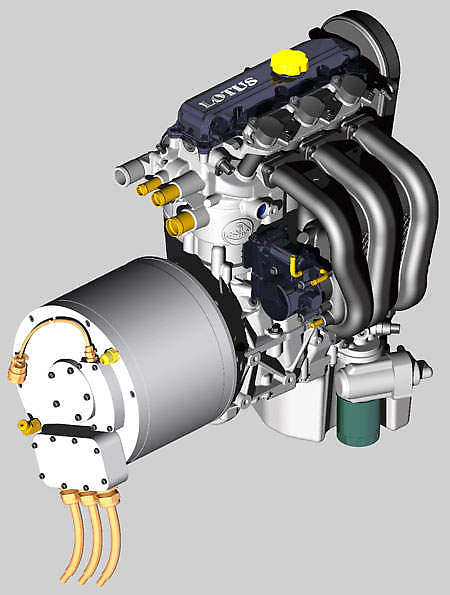
Lotus will be showcasing its very own “range extender” powertrain at the Frankfurt motorshow this month. If you know how the Chevrolet Volt works you’ll basically have a gist about what range extenders are all about. A range extender engine does not power the car’s wheels. It either provides power to an electric motor or charges the vehicle’s battery, depending on needs as per what the management system tells it to do.
The Lotus Range Extender Engine is a 1.2 litre 3 cylinder engine. Its power/torque curve is optimised for 2 power generation points – 15kW (20hp) at 1,500rpm and 35kW (47hp) at 3,500rpm, which by the way is also its redline. The engine is most fuel efficient at these points in the RPM range so it can just run at these speeds without having to go into the other inefficient ranges because it does not drive the wheels directly. Peak torque is 107Nm at 2,500rpm.
The engine is a single cam engine with 2 valves per cylinder on a 10.0:1 compression ratio. It uses a monoblock construction with an integrated exhaust manifold, which means the head and block are integrated, removing the need for a head gasket. 17 parts are eliminated thanks to this and the water jacket can be optimised – the result is a dry weight of only 56kg. No fancy direct injection here – fuel is delivered via port injection and the minimum octane requirement is RON95. It can also run on ethanol or methanol.
Looking to sell your car? Sell it with Carro.





AI-generated Summary ✨
Comments express excitement about Lotus Engineering’s 1.2-liter 3-cylinder range extender engine, highlighting its lightweight design (56kg), efficiency, and potential applications in hybrid vehicles, especially as a range extender for EVs like the Chevy Volt or Proton models. Many enthusiasts see it as a suitable power source due to its optimized power generation points and low weight, which could improve fuel economy and reduce vehicle weight. Some debate the practicality of the engine with concerns about maintenance and efficiency at steady RPM operations. There’s optimism that Proton could adapt this technology for future affordable hybrid or EV vehicles, with suggestions for integration into models like Savvy or Saga. Overall, comments are positive, viewing this as a promising technological showcase that could lead to greener, more efficient cars in Malaysia and beyond.